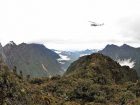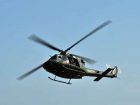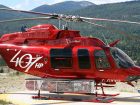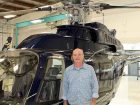
Features
Commercial
Operator Profiles
Thriving in Uncharted Waters
October 23, 2015 By Paul Dixon
Eagle Copter was born in Calgary some 40 years ago, but don’t let its journey into middle age fool you – the company shows little signs of slowing down.
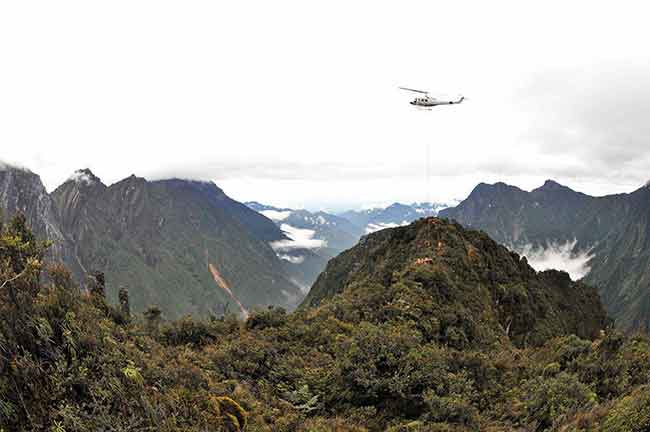 Eagle Copter has some 65 helicopters operating under lease programs around the world.
Eagle Copter has some 65 helicopters operating under lease programs around the world. Mel O’Reilly and three partners started the company with a single helicopter but today, Eagle serves a wide range of government and business customers in Canada and around the world. The company has developed a reputation for having the expertise and ingenuity to solve tough problems and create solutions that stump organizations many times its size. Along its development, O’Reilly bought out his original partners, and in 2003, his son, Mike, succeeded him as president
and CEO.
The management team got that much stronger in August when Barry Kohler, former president of Bell Textron Canada and chair of the Aerospace Association of Canada (AIAC), joined the team, replacing O’Reilly as president and CEO. Shortly after Kohler came aboard, Helicopters had the opportunity to chat with both Mike O’Reilly and Kohler, to discuss how the company got to be where it is today and where it’s headed in the future.
The Secret Recipe
O’Reilly attributes the company’s success in many ways to the concept that “you have to be lucky to be good and good to be lucky.” Seeing an opportunity at the right time is one thing, but it also takes foresight and more than a little bit of courage to head off into uncharted territory.
The business opportunity that Mel O’Reilly recognized and developed was leasing helicopters to other operators. Some four decades ago, leasing was an untested concept in the rotary world, though it was gaining momentum in fixed-wing aviation, especially the large commercial airlines. In the helicopter universe, however, leasing turned out to be a very attractive way for an operator to make money using the helicopter without taking on the additional responsibilities that come with owning that aircraft.
The timing was also right, as there was a distinct shortage of helicopters. Leasing also made helicopters available to operators that didn’t necessarily qualify for the financing required to make a purchase. And from the lessor’s perspective, helicopters became even more valuable, as they proved to appreciate in value over time, which enabled Eagle to grow its lease fleet at an accelerated rate.
O’Reilly said his father also introduced the concept of “power by the hour” – a strategy standard in the Canadian helicopter industry. The “power by the hour” concept – paying for the helicopter on an hourly basis based on job or operation – made life a lot simpler for operators, enabling them to concentrate on making money with their helicopters, while at the same time Eagle was developing its own in-house repair and overhaul capacity.
A Star is Born
By 1985, Eagle’s basic business model was in place. Individual operators could attain a helicopter and lease it out, and get access to a 10,000 square foot repair and overhaul facility. From this point on, O’Reilly says, growth was steady. “It was a very linear growth model, no spikes at all, it just evolved,” he said. “Demand dictated it, and up until 2008, there was a really steady demand for our business.”
Today, Eagle Copter has some 65 helicopters operating under lease programs around the world, and has sold more than 100 helicopters to boot. Its repair and overhaul facility in Calgary now takes up 90,000 square feet, but as O’Reilly notes, it hasn’t all been roses over the past decade. “We didn’t (use to) experience the ups and downs like the OEMS, because there would be lot of fire activity that made up for the highs and lows in the oil and gas business,” O’Reilly said. “What changed in 2008 was the unbelievable oversupply situation we ended up with and I can’t explain that. Global climate change has put us more in the same situation as the OEMs, and we have been experiencing these ups and downs in much the same way.”
While Eagle staked its claim by building the lease, sales and maintenance business, diversification into related and allied fields – which was well under way before the economy fell out – is allowing the company to navigate with a higher degree of assurance in a continuing climate of economic uncertainty.
When O’Reilly took over from his father as president in 2001, Eagle was already acting as the Canadian distributor for various parts and accessories as well as developing some STCs of its own. But the big step forward, O’Reilly notes, happened at a social gathering during a conversation with his insurance broker. “I knew they insured Dart Aerospace as well, so I asked him if he knew what their succession plan was and funny enough, he did,” O’Reilly said. “That enabled me to reach out to Jim Bradly at Dart and, while it took five years, that was the set up and we eventually bought Dart into the fold. It has not only expanded our ability to grow our business, but put a different spin on our repair and overhaul business and our ability to supply parts to the market place. It also provided capacity to the group for manufacturing and engineering services, which was not something we had in the
repair and overhaul sector prior to that.”
Kohler has his own perspective of Eagle’s diversification and specifically, O’Reilly’s keen business acumen and foresight. “Mike is being really humble, but Mel had the original idea and grew the business incredibly well,” Kohler noted. “Then Mike came into the business with a fresh set of eyes and brought an entrepreneurial spirit to it from the perspective of diversifying the overall business portfolio. What Mike has been doing very successfully for more than a decade is figuring out how to grow adjacently in the marketplace, including CSFs in Chile and Australia as well as other partnerships in the global leasing business. What has been very encouraging from our perspective in this unpleasant economy is the diversity and capability of the company, which includes being fairly unique in being able to do engineering projects such as the Eagle Single and 407HP. I think Mike is underselling how well he has been able to look around the helicopter business and decide where we can have a significant impact.”
Those associated with the Canadian helicopter industry need to realize how important it is to read and adapt to market conditions, but it’s even more important to understand your own strengths and weaknesses, and capitalize on an opportunity when it presents itself. Kohler knows this all to well, which is why he joined the Eagle team when he did.
“We are definitely experiencing a downturn in the industry right now and this requires a lot of decisions to be made,” O’Reilly said. “My forte is not necessarily operational and economic metrics, so I was looking for an individual who could help us in those areas. I wasn’t looking at Barry specifically, but we had known each other for a long time on a business level and a personal level. The timing was right for Barry and I was lucky to have him join us at a time when I need his expertise more than anything else.”
From Kohler’s perspective the offer made sense both on a professional and personal level. After serving as president of Bell Helicopters Canada for several years, he had taken a position at Bell’s head office in Texas. “My family had spent a lot of time in Canada and they were very comfortable here and wanted to remain (in Canada). Mike and I have always had a strong relationship. This is something we have both talked about from time to time over the past couple of years and neither of us had killed the idea, so for me it was the perfect storm, if you will.
“I love the helicopter industry, my time with Bell was fantastic and they could not have been more graceful when I made my decision to come to Eagle. My time at Bell gave me insight into the operator community and there was always something in the back of my mind about working in this environment and facing these challenges – the ability to have a more entrepreneurial approach to what I do.”
Kohler describes his first few weeks on the job as “useful and entertaining” as there have been times where his business approach and the company’s have been a little different so to speak. “Melding the two (styles) going forward is going to benefit Eagle,” he said. “I bring a company skill set and Mike brings an entrepreneurial skill set and we want to apply these to a growing company. The benefit of bringing wildly differing viewpoints to situations, is very valuable in allowing us to hone in on an ultimate solution.”
A New Path
The road ahead is far from easy for the new Eagle team. The economic climate is not going to improve overnight, but the diversity O’Reilly has worked to create is going to allow Eagle to ride the storm in relative comfort. “The OEMs aren’t having a lot of fun right now,” O’Reilly said, “and businesses that exist in just one or two markets are going through some degrees of pain that we are fortunately not experiencing. It’s no fun for anyone, but it’s more tolerable for us.”
Eagle’s international footprint – something that has grown steadily since it established a solid base is Canada – is now quite strong. The company has a foothold in Chile, which services the Latin American market, but also has an established clientele in Spain and Portugal. “There is still opportunity for growth down there,” O’Reilly said. “Looking at our basic portfolio, the markets are still growing and we look at them to backfill what we’ve been doing in Canada for the last 20 years.”
Eagle’s new base in Australia represents a window to markets in Southeast Asia – another region that offers growth potential. “It would be very difficult to tap into that market without a local presence and knowledge,” O’Reilly said.
Such a globalized perspective gives the Eagle team a sense of optimism over the next decade. The goal is to take the current product offerings and expand on them, looking to the DART model for some perspective. While Eagle has been known in the industry as being Bell-centric from Day 1, DART has product offerings that are represented by all OEMs.
As Eagle matures and widens its standing in the marketplace, the increased level of capabilities and sophistication in engineering and design is one more example of a company that is ready, willing and able to do what few other companies could dream of. The Eagle Single program, for example, which was developed in-house, sees the Bell 212 converted from a twin-engine to a single-engine helicopter.
This ingenious approach has now been followed by the 407HP program, which transforms a good helicopter, the Bell 407, into a really good helicopter by replacing the original Rolls Royce C47 engine with a Honeywell HST900D-2. The result is a significant increase in horsepower, improved payload and generally increasing the capabilities of the aircraft over a wider operating spectrum, especially in “high and hot” environments.
Honeywell approached O’Reilly and Eagle after the U.S. government cancelled the Armed Reconnaissance Helicopter (ARH) program that Bell was developing. The commercial variant was to be known as the Bell 417, but when the government cancelled the military project Bell decided it was not financially feasible to develop the 417.
Honeywell then found itself with an engine, the HST900D-2, without a hull. Eagle had worked closely with Honeywell on the Super Eagle and this led the Honeywell business development people to approach O’Reilly. Subsequently, Eagle, Bell and Honeywell worked together to develop what is now known as the 407HP. “We had already demonstrated what we could do with the Eagle Single,” O’Reilly said. “There might have been other companies they could have gone with, but the opportunity was there and we were at the right place at the right time. It was quite a challenge.”
Kohler was at Bell back then, on the other side of the looking glass, and he remembers being part of the discussions. “I was a little skeptical Mike could pull this off, because I knew what it took to do something this complex from the OEM standpoint,” Kohler said. “But I ended up being very impressed with the engineering capabilities of the people here and the ability to do things without the vast intellectual horsepower of a huge OEM. It speaks to the unique engineering capability and the unique overall capability of Eagle.” It took five years for Eagle to make the 407HP a reality, with Transport Canada and Federal Aviation Administration approval received in December 2014.
The 407HP conversion is not an inexpensive proposition, much more than simply swapping engines. Eagle currently projects the job at about 1,000 hours, which translates to a month of downtime. It is an exacting process, but with a big payoff as Kohler explains. The 407HP “will have far better productivity and carrying capacity than anything else in its class because of the HST900D-2 engine and the capabilities it will provide.”
Honeywell quantifies the improvement in performance by stating that the 407HP was able to make 32 per cent more bucket lifts in an hour while fighting a fire, with 42 per cent more time on station, though they do not qualify those numbers by total hours or number of aircraft. Calgary’s Elbow River Helicopters took delivery of one of the first 407HPs and company owner and chief pilot Bruce Holloway had the opportunity to fly both the HP and the stock 407 over the summer. His assessment is the 407HP clearly outperforms the stock aircraft when flying under the same conditions.
The realization that clients are becoming increasingly cost-conscious is a key driver in spurring Eagle’s product development. O’Reilly cites the U.S. Forest Service and that agency’s work in assessing various aircraft types in terms of identifying those that are the most cost-effective. “We are attempting to deliver a product, whether it’s a Super 205 or a 407HP, which will have such a competitive advantage that they will have no other choice.” There are more than 1,000 407s in operation around the world and if even a small percentage of operators opt for the conversion, it will keep Eagle busy for years to come.
A Military Perspective
Looking ahead at new business opportunities, Kohler has his eyes firmly set on the upcoming Canadian Forces Griffon Limited Life Extension Program. Projected to cost as much as $1.5 billion over a decade, with the first steps in 2016 and RFP in 2018, Kohler is most emphatic in saying “this project is right in our wheelhouse based on what we’ve done with the Eagle Single and now the 407HP.” He also references the work Eagle has done with the National Research Council on its fly-by-wire 412, upgrading it with the Pratt and Whitney electronically controlled T9 engines in combination with the new Genesis glass cockpit.
O’Reilly can be very self-effacing and it is true that luck does play a role in one’s success. However, it takes more than just being lucky – and more than simply being good at what you do – to succeed. The key is to evolve with the times and not just meet market demands, but also be able to sense a need before it becomes widely accepted. You must also attract (and retain) a team of people who have the ingenuity and creativity to get where you want to be – and this is a talent in its own right. It’s the people that make the difference and it’s the people that make Eagle Copter what it is today – confidently steadily growing in a challenging, ever changing economy.
